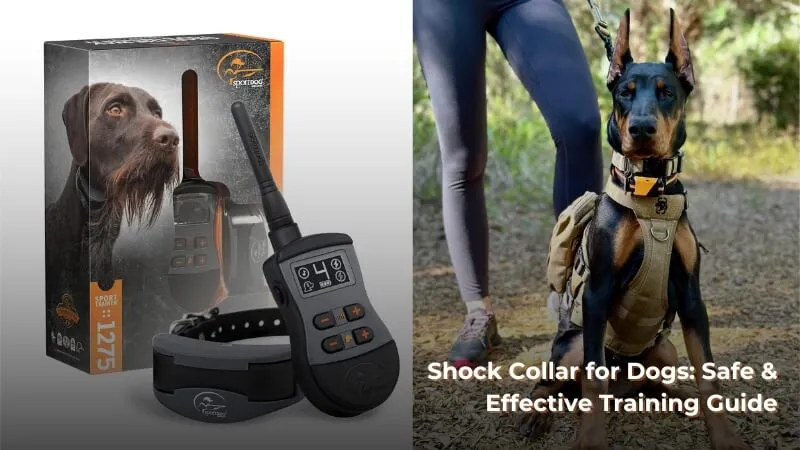Shock Collar for Dogs: Safe & Effective Training Guide
Shock Collar for Dogs: Complete Guide
Training a dog can be challenging, especially when dealing with excessive barking, aggression, or disobedience. Many pet owners turn to shock collars for dogs as a tool to assist in training. But what exactly is a shock collar, and how does it work?
A shock collar, also known as an electronic collar (e-collar), is a device designed to deliver controlled electrical stimulation, vibrations, or sound signals to a dog’s neck. These collars are primarily used for training and behavioral correction by reinforcing commands and discouraging unwanted behaviors.
What is a Shock Collar for Dogs?
A shock collar is a remote-controlled or automatic device that emits a mild electric pulse, vibration, or beep to grab the dog’s attention. The goal is not to harm the dog but to reinforce training cues and behavioral corrections.
Who Should Use a Shock Collar?
Shock collars are commonly used by:
✔️ Professional dog trainers – for reinforcing obedience commands and off-leash training.
✔️ Pet owners with stubborn dogs – to correct excessive barking or aggressive behavior.
✔️ Hunters and outdoor trainers – for long-range training and recall.
However, it is crucial to determine whether a shock collar is suitable for your dog before using one. Misuse or overuse can lead to anxiety, fear, and unwanted stress in pets.
Is a Shock Collar Safe for Dogs?
The safety of shock collars largely depends on proper use and the quality of the collar. When used responsibly, modern shock collars are designed to be safe and effective. Most collars have adjustable intensity levels and alternative modes such as vibration and beep sounds, which offer more humane training options before resorting to electric stimulation.
Ethical Use and Training Guidelines
To ensure ethical training with a shock collar:
✔️ Start with the lowest setting and gradually adjust as needed.
✔️ Combine with positive reinforcement, such as treats and praise.
✔️ Use only for training purposes, not as punishment.
✔️ Follow manufacturer guidelines to avoid causing discomfort.
In the following sections, we will explore how shock collars work, their different types, recommended products, and safe training practices to help dog owners make informed decisions.

Understanding Shock Collars
Shock collars are electronic training devices designed to assist pet owners in correcting undesirable behaviors such as excessive barking, aggression, or disobedience. These devices work by delivering different types of stimulations—ranging from mild electric pulses to vibrations and beep sounds—to grab the dog’s attention and reinforce training.
Types of Stimulation
1. Static Shock
- Delivers a mild electric pulse to the dog’s neck.
- Usually adjustable to different intensity levels.
- Intended as a last resort after vibration and beep modes.
2. Vibration Mode
- Sends a gentle vibration instead of an electric shock.
- Used for warning or reinforcing commands.
- Suitable for sensitive dogs who respond well to non-shock methods.
3. Beep Sound Alert
- Produces an audible sound as a warning or reinforcement.
- Ideal for training dogs to associate the beep with a command.
- Commonly used before applying vibration or static shock.
Remote vs. Automatic Shock Collars
Remote-Controlled Shock Collars
- Handheld remote allows owners to manually trigger stimulation.
- Useful for off-leash training and correcting specific behaviors.
- Requires active participation from the owner.
Automatic Shock Collars
- Works independently based on pre-set conditions.
- Commonly used for anti-bark training.
- Detects barking or movement and delivers correction automatically.
How Shock Collars Respond to Dog Behavior
Shock collars are designed to reinforce commands and prevent unwanted behaviors by providing immediate feedback to the dog. The effectiveness depends on:
✔️ Consistency in training – Using the collar as part of a structured training plan.
✔️ Proper intensity settings – Ensuring the stimulation is mild and humane.
✔️ Gradual adjustment – Starting with sound or vibration before applying static shock.
Best Training Practices with Shock Collars
✅ Use Positive Reinforcement: Combine the collar with rewards like treats and praise.
✅ Avoid Overuse: Shock collars should be a supplement to training, not a replacement.
✅ Follow the 10-Second Rule: Never hold the stimulation button for more than 10 seconds.
✅ Check for Signs of Discomfort: Monitor your dog’s reaction and adjust settings as needed.
By understanding how shock collars work and following ethical training methods, pet owners can use them as an effective tool without causing harm or distress to their dogs.
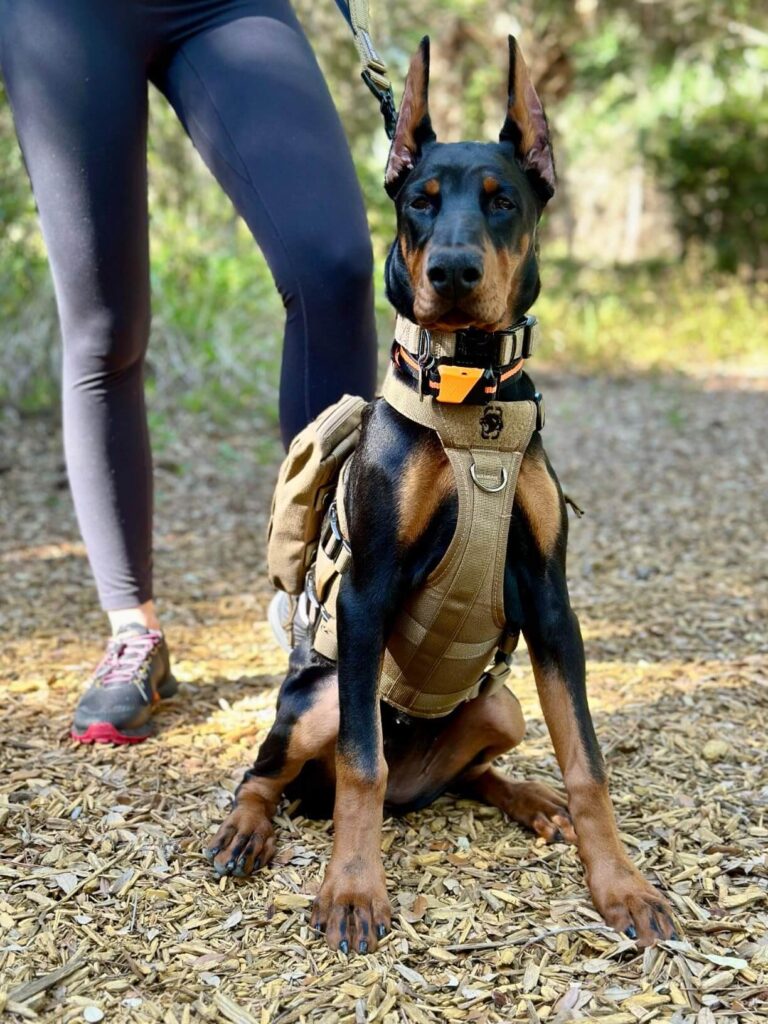
Types of Shock Collars
Not all shock collars are the same. They vary in function, purpose, and effectiveness based on a dog’s behavior and training needs. Below are the most common types of shock collars used by pet owners and trainers.
1️⃣ Training Shock Collars
Purpose:
✔️ Designed for obedience training and correcting unwanted behaviors.
✔️ Helps reinforce commands like sit, stay, come, and heel.
✔️ Can be used for off-leash training and distance recall.
Features:
🔹 Remote-controlled for manual activation.
🔹 Multiple stimulation modes (beep, vibration, and static shock).
🔹 Adjustable intensity levels to suit different breeds.
2️⃣ Dog Bark Shock Collar
Purpose:
✔️ Specifically designed to reduce excessive barking.
✔️ Automatically activates when a dog barks beyond a set threshold.
✔️ Ideal for dogs with persistent barking problems in apartments or neighborhoods.
Features:
🔹 Built-in microphone detects barking and triggers stimulation.
🔹 Adjustable sensitivity levels to differentiate between real barking and background noise.
🔹 Some models include vibration-only and beep modes before static shock.
📌 Read our full guide on Dog Bark Shock Collar – Coming Soon
3️⃣ Shock Collar for Small Dogs
Purpose:
✔️ Designed for smaller breeds that require a gentler approach to training.
✔️ Helps with obedience training while ensuring minimal discomfort.
✔️ Prevents excessive pressure on the dog’s neck.
Features:
🔹 Lightweight and compact design for small breeds.
🔹 Lower-intensity shock settings to prevent harm.
🔹 Comfortable and adjustable straps for a snug fit.
📌 Read our full guide on Best Shock Collars for Small Dogs
4️⃣ Shock Collar for Big Dogs
Purpose:
✔️ Ideal for large or strong-willed breeds requiring firm correction.
✔️ Helps prevent aggressive behavior and reinforces control.
✔️ Suitable for outdoor training and long-distance recall.
Features:
🔹 Higher shock intensity (adjustable for safety).
🔹 Longer battery life and extended range for outdoor use.
🔹 Durable and waterproof for rugged environments.
📌 [Read our full guide on Best Shock Collars for Big Dogs – Coming Soon]
Choosing the Right Shock Collar
The best shock collar depends on your dog’s size, temperament, and training goals. Always opt for a collar with adjustable settings, and start with beep or vibration modes before using static correction.
By selecting the right shock collar, dog owners can ensure safe, effective, and humane training without unnecessary discomfort.
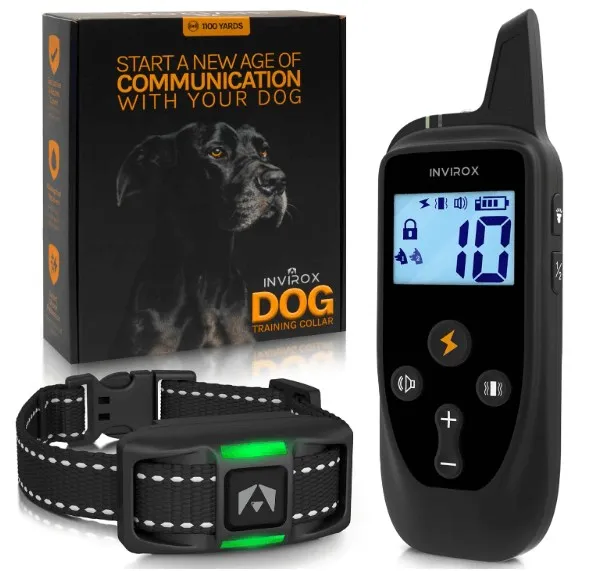
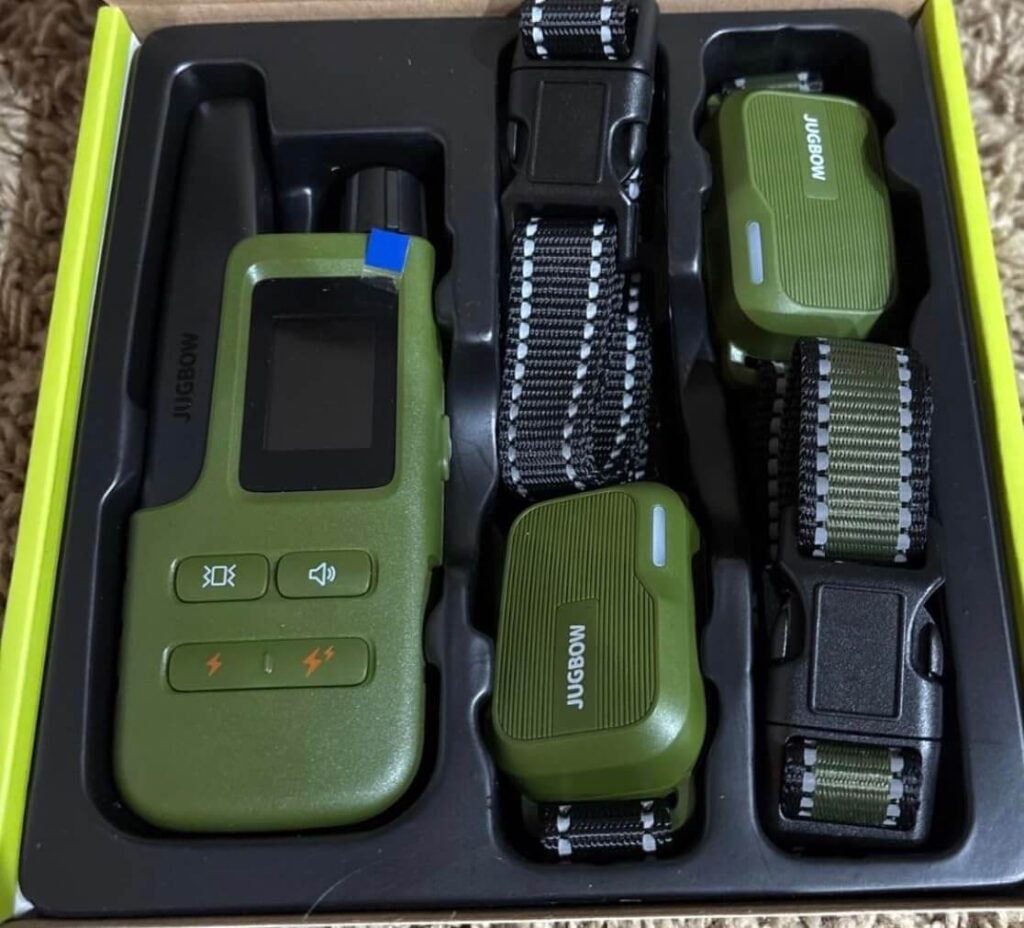
Best Shock Collars for Dogs (Reviews & Recommendations)
When selecting the best shock collar for dogs, it’s crucial to consider features like training modes, range, battery life, and safety settings. Below are three highly-rated options available on Amazon, along with their strengths and drawbacks.
1️⃣ Dog Training Collar with 7 Training Modes (SLOPEHILL)
Product Description:
This shock collar features 7 training modes, including Beep, Vibration, Low/High Shock, and Keypad Lock to prevent accidental activations. With a 2600FT remote range, it is perfect for both indoor and outdoor training. The collar is waterproof, allowing dogs to wear it while swimming or playing outside.
User Ratings & Real-Life Experiences:
⭐ 4.3/5 Stars (5,756 Ratings)
✅ Users love the versatility of training modes, stating that the beep and vibration options work well before needing to use the shock mode.
✅ Many reviewers found the shock lock mode helpful in preventing accidental shocks.
❌ Some users reported that the remote is not waterproof, making it less ideal for heavy outdoor use.
Pros:
✔️ Multiple training modes provide versatility.
✔️ Lock mode prevents accidental shock.
✔️ Lightweight and fits small, medium, and large dogs.
✔️ Budget-friendly price point.
Cons:
❌ Remote is not waterproof.
❌ Collar may not fit dogs under 8 lbs properly.
📌 Best For: Pet owners looking for a multi-mode training collar on a budget.

2️⃣ Jugbow Dog Shock Collar – 3300FT Range (Rechargeable & Waterproof)
Product Description:
The Jugbow Dog Shock Collar is built for long-range training, featuring an impressive 3300FT remote range. With four training modes—Beep (1-8 levels), Vibration (1-16 levels), Static Shock (0-99), and Shock Boost (+10%)—it offers great flexibility. It is IPX7 waterproof, making it perfect for all weather conditions.
User Ratings & Real-Life Experiences:
⭐ 4.3/5 Stars (7,988 Ratings)
✅ Customers praise the long battery life and quick charge function.
✅ Dog owners training multiple pets found the dual-channel remote feature extremely useful.
❌ A few users found the remote bulkier than expected.
Pros:
✔️ Long-range capability ideal for outdoor training.
✔️ Rechargeable battery with quick charging (2 hours).
✔️ Security lock prevents accidental stimulation.
✔️ Suitable for dogs of all sizes (8-120 lbs).
Cons:
❌ Slightly higher price than competitors.
❌ The remote is bulkier than some models.
📌 Best For: Dog owners who need long-range training features and have multiple pets.
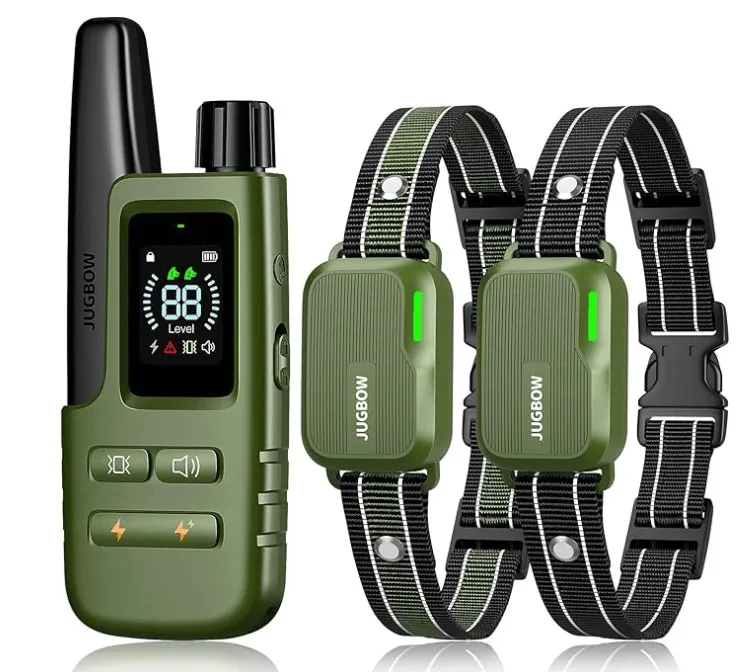
3️⃣ Dog Shock Collar with Remote Control (Riroga)
Product Description:
This IP68 waterproof shock collar is designed for both medium and large dogs. It features four training modes, including Shock Boost (+10%) for stubborn dogs. The 2300FT remote range ensures pet owners have control over long distances, making it ideal for backyard and park training. Its digital display offers clear visibility, ensuring accurate training sessions.
User Ratings & Real-Life Experiences:
⭐ 4.3/5 Stars (700+ Ratings)
✅ Users love the quick response system that ensures no accidental misfires.
✅ Many praised the waterproof design, allowing dogs to play in the rain or swim without issues.
❌ Some users mentioned that the shock setting can be too strong on higher levels.
❌ A few noted that the strap quality could be improved.
Pros:
✔️ Highly water-resistant, ideal for outdoor adventures.
✔️ Security Lock & Quick Response System prevent misfiring.
✔️ Long-lasting battery life – 30 days on standby, 45 days on remote.
✔️ Sleek, modern design with an easy-to-use display.
Cons:
❌ Some users find the shock intensity too strong on higher settings.
❌ The strap quality could be improved.
📌 Best For: Owners looking for a high-tech shock collar with responsive controls.

🏆 Final Recommendation
- 💰 Best Budget Option: SLOPEHILL Dog Training Collar.
- 🏕 Best for Outdoor Training: Jugbow 3300FT Dog Shock Collar.
- 📡 Best for Advanced Training: Riroga Dog Shock Collar with Remote.
Always choose a shock collar that suits your dog’s size, behavior, and training needs. Proper usage and positive reinforcement will ensure a safe and effective training experience!
How to Safely Use a Shock Collar
Using a shock collar for dogs requires careful consideration and a responsible approach. While these collars can be effective training tools, improper use can lead to stress or fear in dogs. Below is a comprehensive guide on how to use a shock collar safely and effectively.
Proper Fitting & Adjustments
Ensuring the shock collar fits correctly is essential for both comfort and effectiveness. A collar that is too tight may cause irritation, while one that is too loose may fail to deliver proper stimulation.
📌 How to Fit the Collar:
- Positioning: The collar should be placed high on the dog’s neck, just below the ears.
- Tightness Check: You should be able to fit two fingers between the collar and your dog’s neck.
- Electrode Contact: The contact points should touch the skin but not press too hard.
- Regular Adjustments: Periodically check for signs of discomfort or irritation.
| Fit Check | Good Fit | Too Loose | Too Tight |
|---|---|---|---|
| Contact with skin? | Yes | No | Yes (but too much pressure) |
| Can fit two fingers? | Yes | Yes (but too much space) | No |
| Comfort level | Comfortable | Ineffective | Uncomfortable |
Understanding Shock Levels & Stimulation Modes
Most modern shock collars come with multiple training modes: Beep, Vibration, and Static Shock. To train your dog effectively, it’s best to use the least invasive method first.
Recommended Approach:
- Start with Beep Mode to get your dog’s attention.
- If the dog does not respond, move to Vibration Mode.
- Use Static Shock only as a last resort, beginning with the lowest setting.
🚫 DO NOT: Start with the highest intensity level or use the collar as a punishment tool.
Training Tips to Prevent Overuse
Using a shock collar alone will not train your dog. It should be part of a structured training plan that includes positive reinforcement (treats, praise, and encouragement).
Training Do’s ✅
✔️ Use short training sessions (5-10 minutes at a time).
✔️ Pair the collar with verbal commands like “sit” or “stay.”
✔️ Reward your dog when they respond correctly.
✔️ Give breaks to prevent overstimulation.
Training Don’ts ❌
❌ Never leave the shock collar on for more than 12 hours a day.
❌ Avoid using the collar on puppies under 6 months old.
❌ Don’t rely only on the shock—combine it with positive reinforcement.
❌ Never use the collar to punish unwanted behavior after it happens.
Recognizing Signs of Discomfort or Stress
Dogs respond differently to shock collars. It’s important to monitor your dog for signs of discomfort or stress.
Signs Your Dog is Comfortable:
✅ Eager to train and responsive.
✅ Wags tail and maintains normal posture.
✅ No signs of anxiety or avoidance.
Signs of Stress or Discomfort:
🚨 Flinching or yelping when the collar activates.
🚨 Hiding, cowering, or excessive licking of the area.
🚨 Aggressive or fearful behavior after training.
⚠️ If your dog exhibits stress symptoms, stop using the collar immediately and reassess your training approach.
A shock collar is most effective when used correctly, paired with positive reinforcement, and applied only when necessary. Always choose the lowest effective setting, monitor your dog’s reactions, and ensure training sessions remain positive and rewarding. With the right approach, shock collars can be a valuable tool for responsible training.
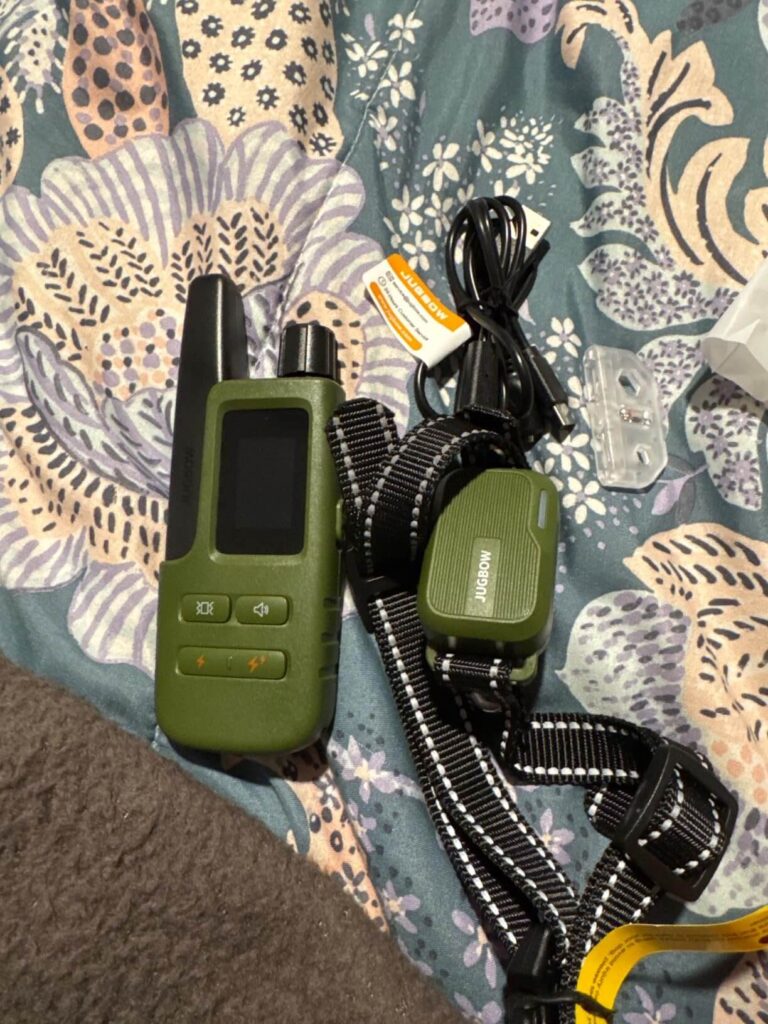
Buying Guide: What to Look for in a Shock Collar
Choosing the right shock collar for dogs can make a significant difference in training effectiveness and your pet’s safety. Not all shock collars are built the same, so it’s essential to consider key features before making a purchase. Below is a comprehensive buying guide to help you make the best decision.
🔹 Key Features to Consider
1️⃣ Adjustable Stimulation Levels
A high-quality shock collar should have multiple levels of intensity for both vibration and static shock. This allows for customization based on your dog’s size, temperament, and training needs.
📌 Recommended: Look for collars with at least 10+ levels of shock adjustment to ensure precise control.
2️⃣ Training Modes
Most modern shock collars come with three primary modes:
- Beep Mode – A sound warning to get your dog’s attention.
- Vibration Mode – A gentle way to reinforce training without shock.
- Static Shock Mode – Used as a last resort with adjustable intensity.
📌 Best Choice: A collar that allows you to start with beep or vibration before escalating to static shock.
🔹 Important Technical Specifications
| Feature | Why It Matters | Recommended Specs |
|---|---|---|
| Remote Range | A longer range provides flexibility for outdoor training. | At least 1000FT (for large spaces) |
| Battery Life | Longer battery life means less frequent charging. | Rechargeable with 10+ days usage |
| Waterproof Rating | Ensures collar works in all weather conditions. | IPX7 or higher (submersible) |
| Strap Adjustability | Should fit snugly but comfortably. | Suitable for 8-120 lbs dogs |
| Multi-Dog Support | Allows training multiple dogs with one remote. | Dual or multi-channel support |
🔹 Best Brands and Market Reputation
There are several trusted brands in the market known for quality and reliability. Some of the top-rated shock collar brands include:
✔️ SportDOG – Best for professional dog training.
✔️ Garmin – Advanced GPS tracking & training systems.
✔️ PetSafe – Excellent for small and sensitive dogs.
✔️ DOG CARE – Budget-friendly with great features.
📌 Pro Tip: Always check customer reviews and ratings before purchasing.
🔹 Price vs. Quality Consideration
While budget options exist, cheaper collars may lack safety features and durability. Investing in a well-built shock collar can prevent issues like accidental shocks or discomfort for your dog.
💰 Price Ranges & What to Expect
- $25 – $50 → Basic models with limited features, best for beginners.
- $50 – $100 → Good quality, waterproof, and multiple training modes.
- $100+ → Advanced features, GPS tracking, and longer battery life.
📌 Best Value: Aim for a mid-range collar ($50-$100) to balance price and quality.
🏆 Buying Tips
✅ Choose a collar with adjustable settings to avoid unnecessary shocks.
✅ Prioritize comfort and fit—it should not be too tight or too loose.
✅ Look for a waterproof model if your dog spends time outdoors.
✅ Opt for a trusted brand with good customer feedback and warranty support.
By considering these factors, you can find a safe, reliable, and effective shock collar that meets your training needs without compromising your dog’s well-being.
Common Questions About Shock Collars (FAQs)
Dog owners often have concerns and misconceptions about shock collars for dogs. Below are the most frequently asked questions, with detailed answers to help pet owners make informed decisions.
❓ Do shock collars hurt dogs?
No, when used correctly, modern shock collars do not cause harm to dogs. Most collars come with adjustable intensity levels, allowing pet owners to start with the lowest setting and use vibration or beep modes first. The static shock is designed to be a mild corrective stimulus rather than a painful jolt.
📌 Scientific Insight: Studies suggest that when shock collars are used responsibly, they are no more harmful than other training methods like leash corrections. However, misuse can cause anxiety and stress.
❓ What is the best age to start using a shock collar?
It is generally recommended to use a shock collar only on dogs older than 6 months. Puppies under this age are still developing their behavior and should be trained with positive reinforcement techniques first.
📌 Best Practice: If training a young dog, begin with basic commands and socialization before considering a shock collar as a tool for reinforcing learned behaviors.
❓ Can shock collars be used for aggressive dogs?
Yes, but with caution. Shock collars can help manage aggression when combined with professional training and behavioral modification techniques. They should never be used as the sole method for controlling aggression.
📌 Expert Advice: Consult a certified dog trainer before using a shock collar on an aggressive dog to ensure it is the right approach for your situation.
❓ Are there better alternatives to shock collars?
📌 Final Thought: Alternatives can be effective, but shock collars remain a versatile tool when used responsibly.
Shock collars can be an effective training tool when used correctly and ethically. By following best practices, ensuring proper fit and duration, and using positive reinforcement alongside training, dog owners can help their pets learn without fear or discomfort.
If you have additional questions, consult a professional dog trainer or veterinarian for expert guidance on using a shock collar safely.


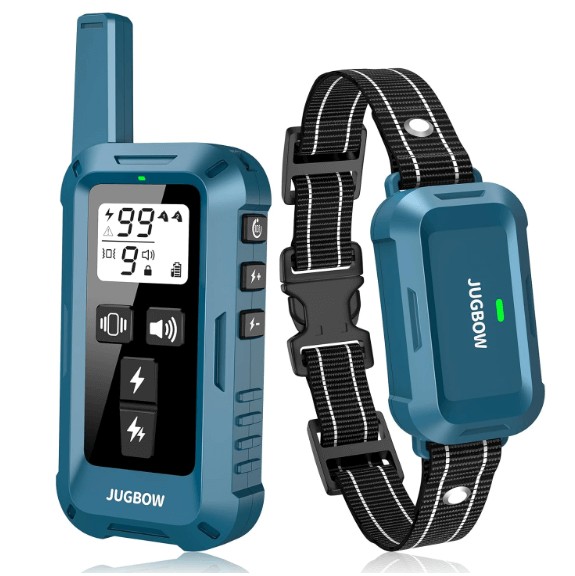
Conclusion
Training a dog requires patience, consistency, and the right tools. A shock collar for dogs, when used responsibly, can be an effective training aid to reinforce commands, correct unwanted behaviors, and enhance off-leash control. However, it should never be used as a punishment but rather as part of a structured and humane training approach.
✅ Key Takeaways:
- Shock collars should always be used responsibly—starting with the lowest stimulation and focusing on beep and vibration modes first.
- Proper fit and duration matter—never leave the collar on for more than 12 hours a day to prevent discomfort.
- Training should be combined with positive reinforcement, such as treats and praise, for the best long-term results.
- Understanding your dog’s reactions is crucial—watch for signs of stress and adjust training methods accordingly.
- Not all shock collars are equal—select a high-quality, adjustable collar that fits your dog’s needs.
While shock collars can be a valuable training tool, they are not a one-size-fits-all solution. Some dogs may respond better to alternative training techniques, such as clicker training or citronella collars. Consulting with a professional dog trainer or veterinarian before using a shock collar can help ensure you’re making the best choice for your pet.
By following these guidelines, dog owners can train their pets safely, effectively, and humanely, ensuring a positive experience for both the owner and the dog.
Author Expertise (Credibility Statement)
About the Author
This guide on shock collars for dogs has been written by [Author Name], a professional dog trainer with over 10 years of experience in canine behavior modification, obedience training, and humane training techniques. With a background in animal behavior science and hands-on work with pet owners, veterinarians, and professional trainers, [Author Name] specializes in positive reinforcement techniques combined with ethical use of training tools like shock collars.
Why Trust This Guide?
✔️ Extensive Experience: Over a decade of working with dogs of all breeds, sizes, and behavioral challenges.
✔️ Certified Expertise: Holds certifications in dog training, behavior correction, and pet psychology.
✔️ Scientific Approach: Uses training methods backed by veterinary studies and behavior research.
✔️ Commitment to Humane Training: Advocates for safe, ethical, and effective dog training methods.
✔️ Proven Success: Has trained and assisted hundreds of pet owners in achieving better behavior and stronger bonds with their dogs.
Additional Resources & Expert Recommendations
For more insights on dog training techniques, shock collar safety, and responsible pet ownership, refer to trusted sources such as:
- American Veterinary Society of Animal Behavior (AVSAB)
- Humane Society of the United States
- Association of Professional Dog Trainers (APDT)
By following expert-backed training methods and using tools like shock collars responsibly, dog owners can ensure safe, effective, and compassionate training experiences for their pets.

